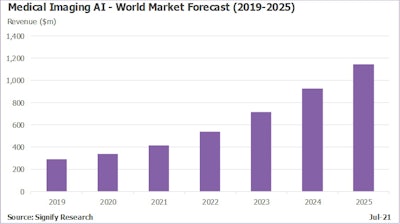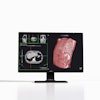
The world market for medical imaging artificial intelligence (AI) applications is projected to reach almost $1.2 billion by 2025, with a compound annual growth rate (CAGR) of 26%, according to a new report from Signify Research.
 Sanjay M. Parekh, PhD.
Sanjay M. Parekh, PhD.Despite the COVID-19 pandemic, there have been several positive developments for the medical imaging AI market in 2020 and 2021 (to date). These include new product launches (a record number of AI software applications received U.S. Food and Drug Administration clearance in 2020), new reimbursement codes (such as the new technology add-on payment reimbursement for stroke imaging AI in the U.S.), and the first wave of class III national medical products administration approvals in China (permitting the use of medical imaging AI software for diagnostic purposes).
 The medical imaging AI world market forecast (2019-2025).
The medical imaging AI world market forecast (2019-2025).However, several barriers are still holding the market back and need to be addressed. These include the limited number of clinical validation studies that show the efficacy and efficiency of AI technology and limited real-world studies to demonstrate the health economic benefits of AI, to name but a few. Signify Research's report includes a forecast for the medical imaging AI market (Figure 1), which shows increasing growth towards the end of the period, with peak annual growth of 33% in 2023 as the COVID-19 pandemic subsides and customer confidence in AI increases.
Growth in the medical imaging AI market has been slower than anticipated, but progress is being made. However, customers will need to know the real-world impact of AI and the return on investment for the market to go on and reach its full potential.
The report findings showed that stand-alone AI software applications account for most of the medical imaging AI market, but one-third of this market is accounted for by AI tools bundled with advanced visualization (AV) platforms. The market for stand-alone AI applications is forecasted to grow faster (31.9% CAGR) than the market for AV-bundled AI tools (3.9% CAGR) and will account for almost 90% of the total medical imaging AI market by the end of the forecast period (2025).
Most of the medical imaging AI market (85%) is accounted for by four clinical applications, namely (in order of market size): cardiology, neurology, breast, and pulmonology. These four clinical applications are projected to still dominate the market in 2025 with 82% of total revenue. The number of new product introductions of AI solutions for other clinical segments is on the rise, though, most notably for prostate and liver imaging. However, the lack of reimbursement will initially hold back their market uptake.
Despite skepticism in some corners, this is an exciting market. Medical imaging AI is unquestionably becoming an increasingly important technology within radiology.
Most medical imaging AI vendors remain focused on automating image analysis and improving workflow efficiencies. However, in the mid-to-longer term, market growth will depend on vendors delivering value beyond the primary read, for example, identifying incidentals to avoid missed diagnoses, using quantitative imaging to reduce the need for biopsy, or reducing the turn-around time for critical cases such as stroke care.
Vendors may also look beyond radiology, for example by developing companion diagnostic tools in a bid to partner with pharmaceutical and medical device companies, or population health tools to aid healthcare providers diagnose chronic conditions earlier, enabling better treatment and management of these patients.
Ultimately, it will be the solutions that significantly improve patient care that are most likely to receive reimbursement and hence drive market growth.
Sanjay Parekh, PhD, is a senior analyst at Signify Research, a health tech, market-intelligence firm based in Cranfield, U.K.
The comments and observations expressed do not necessarily reflect the opinions of Auntminnie.com or AuntMinnieEurope.com, nor should they be construed as an endorsement or admonishment of any particular vendor, analyst, industry consultant, or consulting group.



















